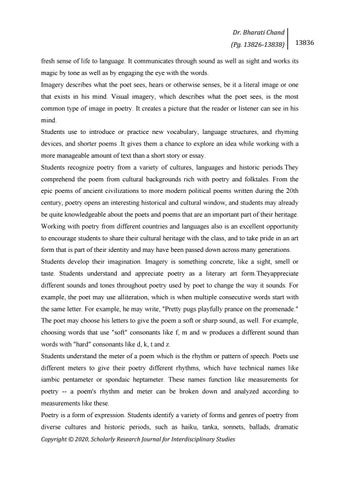Dr. Bharati Chand (Pg. 13826-13838)
13836
fresh sense of life to language. It communicates through sound as well as sight and works its magic by tone as well as by engaging the eye with the words. Imagery describes what the poet sees, hears or otherwise senses, be it a literal image or one that exists in his mind. Visual imagery, which describes what the poet sees, is the most common type of image in poetry. It creates a picture that the reader or listener can see in his mind. Students use to introduce or practice new vocabulary, language structures, and rhyming devices, and shorter poems .It gives them a chance to explore an idea while working with a more manageable amount of text than a short story or essay. Students recognize poetry from a variety of cultures, languages and historic periods.They comprehend the poem from cultural backgrounds rich with poetry and folktales. From the epic poems of ancient civilizations to more modern political poems written during the 20th century, poetry opens an interesting historical and cultural window, and students may already be quite knowledgeable about the poets and poems that are an important part of their heritage. Working with poetry from different countries and languages also is an excellent opportunity to encourage students to share their cultural heritage with the class, and to take pride in an art form that is part of their identity and may have been passed down across many generations. Students develop their imagination. Imagery is something concrete, like a sight, smell or taste. Students understand and appreciate poetry as a literary art form.Theyappreciate different sounds and tones throughout poetry used by poet to change the way it sounds. For example, the poet may use alliteration, which is when multiple consecutive words start with the same letter. For example, he may write, "Pretty pugs playfully prance on the promenade." The poet may choose his letters to give the poem a soft or sharp sound, as well. For example, choosing words that use "soft" consonants like f, m and w produces a different sound than words with "hard" consonants like d, k, t and z. Students understand the meter of a poem which is the rhythm or pattern of speech. Poets use different meters to give their poetry different rhythms, which have technical names like iambic pentameter or spondaic heptameter. These names function like measurements for poetry -- a poem's rhythm and meter can be broken down and analyzed according to measurements like these. Poetry is a form of expression. Students identify a variety of forms and genres of poetry from diverse cultures and historic periods, such as haiku, tanka, sonnets, ballads, dramatic Copyright Š 2020, Scholarly Research Journal for Interdisciplinary Studies

